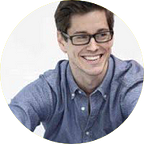Week 20, 2019
Fulfillment: Mindset, Focus, and Method
Each week I share three ideas for how to make work better. And this week, those ideas come from a presentation I’m working on. It’s a best-of compilation of sorts. If you’ve paid attention over the past weeks and months, you’ve probably heard it before. But the packaging is different, as summarized by this nifty little algorithm:
Let’s dig right in.
1. A New Mindset
In 1960, Douglas McGregor published his seminal The Human Side of Enterprise. In that book, he described a new theory of workforce motivation: Theory X and Theory Y. Whereas the former assumed people disliked work and wanted to avoid it, the latter assumed the opposite: that work was natural and a source of fulfillment. Sixty years hence and it's clear Theory X won out. Most organizations today are based on this fundamental premise: that workers can’t be trusted and that they need to be managed and controlled. But it doesn’t have to be this way. There are alternatives. Organizations in industries as wide-ranging as Manufacturing and Healthcare have achieved great success by adopting Theory Y. They’ve achieved growth by ditching bureaucracy in favor of trust and empowerment. And the world has (finally) started to take note.
For more on this, go straight to the source: McGregor’s The Human Side of Enterprise on Amazon.
2. A New Focus
This newfound interest in workplace motivation has spurred a number of new tools and services. Just consider the plethora of Employee Engagement platforms now available. In a world where only 34% of the workforce is actively engaged (Gallup, 2018), these platforms are designed to help us track and improve engagement over time. It’s a worthwhile sentiment. But engagement is not personally relevant; no one has ever said “engagement” is their ultimate goal in life. As individuals, we seek fulfillment. And fulfillment, at work, translates into engagement. So why not go straight to the source? Ask workers if they are fulfilled. And if they’re not, ask what can be done to change the situation? If we truly want to build on Theory Y, we need to start with personal fulfillment.
For more on this, check out [Week 3 2019]Fulfillment: Relationships, Impact, and Personal Growth.
3. A New Method
What’s the difference between something that is “complicated” versus “complex”? An engine is complicated: it has lots of moving parts, but the parts are readily observable. Traffic, on the other hand, is complex: its inner workings are shrouded in mystery. It’s an apt analogy because Theory X organizations “pretend” organizations are complicated when they are, in fact, complex. And as a result, they try and fail to predict and control. Theory Y on the other hand, accepts that complexity cannot be controlled, only managed. And so instead of sweeping control mechanism, it relies on series of build-measure-learn experiments. Fulfillment leads to engagement, not the other way around. And so instead of sweeping reorgs and policy changes, we should do less, more often, and continuously improve the employee experience.
OKRs can be helpful when running experiments, see w282018.
The thesis here is that the right mindset (Theory Y), the right focus (Fulfillment), and the right method (Experimentation) produce growth — personal and financial. And that’s important. Corporate longevity is on a steady decline (see w182019): from 60+ years in the 1950s to 24 years today. And it’s predicted to decrease to just 12 years within the next decade.
Why? Because technological and socioeconomic forces are working to rapidly increase the rate of change. This is the VUCA world everybody is talking about (w102019). And if your organization can’t adapt fast enough, you are sure to be left by the wayside. It’s a financial imperative — it just so happens that this imperative (as opposed to, say, industrialization) aligns business interests with the interests of individual workers. It’s a win-win. And hopefully, that will help the medicine go down.
That’s all for this week.
Until next time: make it matter.
/Andreas
PS. The presentation itself goes into a lot more depth. Enough to fill 45 min with diagrams, quotes, and methods, etc. Send me an email if you’re interested to know more. And feel free to peruse the slide deck, it’s available online.
